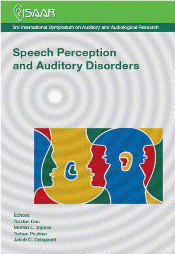The effect of a linked bilateral noise reduction processing on speech in noise performance
Abstract
Directional processing already provides tangible noise reduction benefits in hearing aids but further improvement is needed for hearing-impaired listeners to communicate as effectively as normal-hearing listeners in noisy environments. The objective of this study was to investigate if a binaurally linked beamformer could further improve the signal-to-noise ratio (SNR). Speech reception thresholds (SRT) and spatial perception were compared for bilaterally fitted cardioid microphones and two binaurally linked beamformer processing conditions; 1) a single audio stream output to the two ears, and 2) two audio stream outputs which preserved spatial cues. 10 normal-hearing and 22 hearing-impaired listeners were recruited for this study. The strategies were implemented on a real-time PC processing platform, wired to a pair of behind-the-ear devices via a sound interface. A speech-in-noise test was administered using the Bamford-Kowal-Bench (BKB) sentences targeting the SNR for which 75% correct keywords were identified in spatially separated multi-talker babble noise and room reverberation. The SNR level at which the listeners acquired 95% intelligibility from continues speech discourse material, using a male and a female talker, was also obtained. Sound amplification was provided according to NAL-NL2. Both beamformer conditions improved the SRTs relative to the conventional cardioids, but by a greater degree for the hearing-impaired listeners, and more convincingly at the higher SRTs.
References
Bench, R. J., Doyle, J., Daly, N., Lind, C. (1979). “The BKB/A Speech-reading (lip- reading) test” Victoria: La Trobe University.
Blauert, J., (1997). “Spatial hearing-The psychophysics of human sound localisation”. The MIT Press, England.
Blauert, J., (2005). Communication acoustics, Springer-Verlag, The Netherlands. Brandstein, M., and Ward, D., (2001). Microphone arrays - Signal processing techniques and applications, Springer-Verlag, Germany.
Dillon, H. (2010). “Mild hearing loss is serious business” International Hearing Aid Research Conference, August 11-15, Lake
Kates, J. M., (2008). Digital hearing aids, Plural Publishing, Inc, CA USA.
Keidser, G. (1995). “Long-term spectra of a range of real-life noisy environments” Aust. J. Audiol., 17, 39-46.
Keidser, G., Ching, T., Dillon, H., Agung, K., Brew, C., Brewer, S., Fisher, M., Foster, L., Grant, F., and Storey, L. (2002). “The National Acoustic Laboratories’ (NAL) CDs of Speech and Noise for Hearing Aid Evaluation: Normative Data and Potential Applications”. Austr. & N.Z. J. Audiol. 24,16-35.
Keidser, G., Dillon, H., Flax, M., Ching, T., and Brewer, S. (2011). “The NAL-NL2 prescription procedure” Audiology Research 1:e24: 88-90.
Markides, A., (1997). Binaural hearing aids, Academic Press.
Mejia., J., Dillon, H., and Carlile, S. (2006) ”A method and system for enhancing the intelligibility of sounds” WO/2007/137364.
Mejia, J., and Dillon, H., (2010). “A system and method for producing a directional output signal” WIPO Patent Application WO/2010/051606
Pearsons, K. S., Bennett, R. L., and Fidell, S. (1977). “Speech levels in various noise environments” Washington, D.C., U.S. Environmental Protection Agency
Powers, T. A., and Hamacher, V., (2002). “A Three-microphone instrument is designed to extend benefits of directionality” The Hearing Journal, 55. No.10. October.
Soede, W., (1990) Improvement of speech intelligibility in noise, N.K.B. Offset bv, Bleiswijk., The Netherlands.
Additional Files
Published
How to Cite
Issue
Section
License
Authors who publish with this journal agree to the following terms:
a. Authors retain copyright* and grant the journal right of first publication with the work simultaneously licensed under a Creative Commons Attribution License that allows others to share the work with an acknowledgement of the work's authorship and initial publication in this journal.
b. Authors are able to enter into separate, additional contractual arrangements for the non-exclusive distribution of the journal's published version of the work (e.g., post it to an institutional repository or publish it in a book), with an acknowledgement of its initial publication in this journal.
c. Authors are permitted and encouraged to post their work online (e.g., in institutional repositories or on their website) prior to and during the submission process, as it can lead to productive exchanges, as well as earlier and greater citation of published work (See The Effect of Open Access).
*From the 2017 issue onward. The Danavox Jubilee Foundation owns the copyright of all articles published in the 1969-2015 issues. However, authors are still allowed to share the work with an acknowledgement of the work's authorship and initial publication in this journal.


